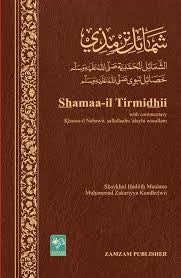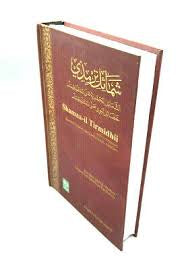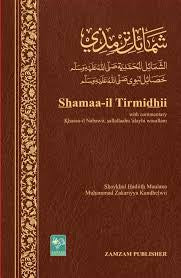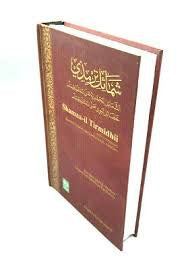Bookstore JQU
Shamaail Tirmidhi with commentary by Moulana Zakariyya Kandhalwi - شمائل ترمذي
Shamaail Tirmidhi with commentary by Moulana Zakariyya Kandhalwi - شمائل ترمذي
Couldn't load pickup availability
This is a Commentary on the abridged form of Imam Tirmidhi's (209 - 279 AH) famous Shamaa-il, in which he has recorded everything about the Holy Propet (S.A.W) on the authority of the Companions, and collected 397 ahadith which are divided into 55 Chapters. Drawing A pen picture of the Holy Prophet's (S.A.W) physical features manners and characteristics.
This English translation and commentary is of the Khasaa-il Nabawi Sallallahu 'Alayhi Wasallam by the late Shaykhul Hadith Maulana Muhammad Zakariyya.
It is intended to enable a Muslim to achieve a link and connection with the one whom Allah Ta'aala has made as a mercy unto mankind, and most certainly Allah has spoken the truth when He mentions in His Book:
'Verily, you (0 Muhammad) are of a very high (noble) character".
Shaikh ul Hadith Maulana Muhammad Zakariyya Kandhelwi writes the following in the Preface to this book:
- Most of the references in this translation are derived from the following books: 'Jam'ul Wasaa-il' of Mulla 'Ali Qaari Hanafi; 'Munaawi' of Shaykh 'Abdur-Ra-oof Misri; 'Mawaahib-Ladunniyyah' of Shaykh Ebrahim Bayjuri and 'Tah-dhibut Tah-dhib' of Haafiz Ibn Hajar 'Asqalaani.
- Since the translation is meant for the layman, literal meanings have been given . Word for word translation has been avoided.
- In addition to the translation many things have been added to serve as a commentary. This has been written separately after the actual translation.
- At many places in the translation of the ahaadith additional information has been provided.
- Where there seems to be contradiction between two hadith, the differences have been briefly explained.
- The view of the different madhaa-hib have been mentioned briefly at places. The Hanafi mahd-dab has been specially mentioned as the majority of the local population (i.e the inhabitants of India ) adhere to this madh-hab.
- The proof that substantiate the Hanfis madh-hab have been mentioned briefly where deemed necessary.
- Where a battle or incident is mentioned in a hadith, the battle or incident is described in the commentary.
- Where the relation of a hadith to a chapter is not obvious, an explanation has been provided.
- To keep the subject matter brief, with regard to those incidents that have not been narrated herein, the readers have been referred to their original sources. The name of the kittab is given where they can be found in detail so that those who are interested may easily refer to them.
- Utmost care has been taken to keep the subject under discussion short and precise, as readers may become bored with lengthy discourses.
About Imam Tirmidhi
Imam Muhammad ibn Easa ibn Sawrah ibn Musa Tirmidhi was born in the year 209 A.H. during the reign of the Abbasid Khalifa Ma'mun al-Rashid. Having grown up in an environment of learning, together with possessing many great qualities naturally drove Imam Tirmidhi to dedicate his life totally towards the field of Hadith. He obtained his basic knowledge at home and later travelled to far off lands in search of this great science.
He studied Hadith under great personalities such as Imam Bukhari, Imam Muslim and Imam Abu Dawud. In some narrations Imam Bukhari and Imam Muslim are his students as well. According to Ibn Taymiyya and Shah Waliullah, Imam Timidhi was an independent Jurist (Mujtahid). Moulana Anwar Shah Kashmiri is of the opinion that he was a Shafi`i.
He died In the year 279 A.H. in a village called Bawag at the age of 70.
About Imam Commentator
Shaykhul Hadith Maulana Muhammad Zakariyya Kandhelwi was born in the village of Kandhla (in Uttar Pradesh, India) on Ramadan 1315 AH (1898 CE). His full name was Muhammad Zakariyya ibn Muhammad Yahya ibn Muhammad Isma‘il, and his lineage continues all the way back to Abu Bakr (may Allah be pleased with him), the great Companion of the Messenger (upon him be peace).
He spent 55 years teaching Ahaadith. of which 45 years were spent in teaching Bukhari Sharif.As an author he wrote many important books. Awjazul-Masaalik, commentary of Muatta Imam Malik in fifteen volumes and La’miud-Dirari, commentary of Sahih-al-Bukhari, consisting of over ten volumes. He has also written a compilation of books on virtues in various different subjects.
In the last century, India has undoubtedly become an important center for the study of hadith, and the scholars of India have become well-known for their passion for religious knowledge. Upon them ended the era of leadership in teaching hadiths, codification of the special fields (funun) of hadith, and commentary upon its texts (mutun).
He was given the honorary title of Shaykh al-Hadith, or “Great Scholar of Hadith,” by his teacher, Shaykh Khalil Ahmad Saharanpuri, who recognized his deep insight, clear-sightedness, and extensive knowledge of hadith and related sciences.
Maulana Zakariya Died in 1402 AH (1982)
Materials
Materials
Shipping & Returns
Shipping & Returns
Dimensions
Dimensions
Care Instructions
Care Instructions
Share


-
Hassle-Free Exchanges

